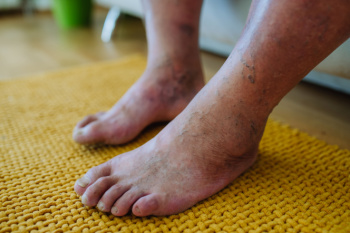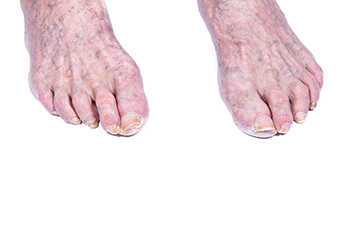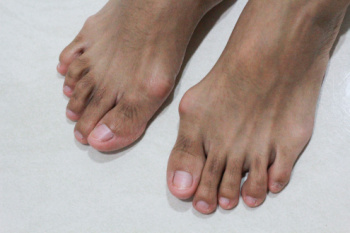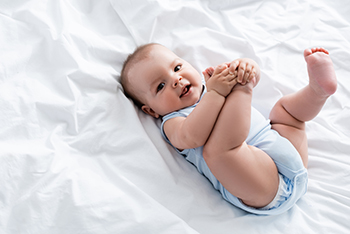
Diabetes can affect your feet in ways that are not always obvious at first. Reduced blood flow and nerve damage may lead to numbness, tingling, or a loss of sensation, making it easy to overlook injuries or irritation. You may not notice a blister, cut, or sore until it becomes infected or fails to heal. Swelling, redness, or drainage from a wound are signs that should not be ignored. Changes in skin color or temperature, especially when paired with pain or unusual smells, may indicate more serious issues like infection or poor circulation. Even dry, cracked skin can be a warning sign. Because diabetic foot problems can develop quickly and lead to serious complications, early attention is essential. Regular foot checks are important, but if you observe any of these signs or changes, it is suggested that you see a podiatrist who can help you to manage this condition.
Diabetic foot care is important in preventing foot ailments such as ulcers. If you are suffering from diabetes or have any other concerns about your feet, contact Ramin Nadjafi, DPM from Advanced Podiatry Group. Our doctor can provide the care you need to keep you pain-free and on your feet.
Diabetic Foot Care
Diabetes affects millions of people every year. The condition can damage blood vessels in many parts of the body, especially the feet. Because of this, taking care of your feet is essential if you have diabetes, and having a podiatrist help monitor your foot health is highly recommended.
The Importance of Caring for Your Feet
- Routinely inspect your feet for bruises or sores.
- Wear socks that fit your feet comfortably.
- Wear comfortable shoes that provide adequate support.
Patients with diabetes should have their doctor monitor their blood levels, as blood sugar levels play such a huge role in diabetic care. Monitoring these levels on a regular basis is highly advised.
It is always best to inform your healthcare professional of any concerns you may have regarding your feet, especially for diabetic patients. Early treatment and routine foot examinations are keys to maintaining proper health, especially because severe complications can arise if proper treatment is not applied.
If you have any questions please feel free to contact our office located in Orlando, FL . We offer the newest diagnostic and treatment technologies for all your foot and ankle needs.

As individuals age, foot problems become more common and can significantly affect mobility and quality of life. Frailty and decreased motor performance contribute to issues such as reduced balance, slower walking speed, and increased risk of falls. Conditions such as arthritis, neuropathy, and poor circulation can lead to pain, stiffness, and difficulty in movement. Weakening muscles and loss of flexibility in the feet may cause instability, making everyday activities more challenging. Common problems include bunions, corns, calluses, and deformities that worsen with age. Proper foot care, wearing supportive shoes, and regular exercise can help maintain strength and function. If you are elderly and have developed foot conditions or noticed any changes to your feet, it is suggested that you are under the care of a podiatrist who can help you to monitor your foot health.
If you need your feet checked, contact Ramin Nadjafi, DPM of Advanced Podiatry Group. Our doctor will attend to all of your foot and ankle needs and provide you with quality treatment.
Geriatrics and Podiatry
When people age, some common issues that may occur are bone density loss, dry skin, poor circulation, and rough brittle nails. These issues may also affect your foot health if the necessary steps are not taken to alleviate the problems.
It is important to take care of your feet because feet that are injured or diseased can affect your overall health. Having painful feet hinders your ability to do daily activities or may decrease your willingness to do the things that you need to do.
Visiting Your Geriatrician
As we age, health problems become more likely, so it is essential to visit your doctor for check-ups to ensure that you are doing the best you can to take care of your health. It is recommended to check your feet frequently for any possible cuts, bruises, swelling, corns or any other irregularities.
Taking Care of Elderly Feet
Cracked or dry feet can be treated by applying moisturizer often. It is also important not to wear old socks because the older the sock is, the higher the possibility there will be that there is bacteria there. Wear fresh socks and make sure they fit properly.
Proper foot health means that you can have a more active lifestyle and you will not be bogged down by pain. Foot health also leads to good circulation, which is paramount for overall health.
If you have any questions, please feel free to contact our office located in Orlando, FL . We offer the newest diagnostic tools and technology to treat your foot and ankle needs.

A bunion, or hallux valgus, is a bony bump that forms at the base of the big toe. A bunion develops gradually as the big toe shifts inward toward the smaller toes and places stress on the joint. Because this joint supports a significant amount of weight while walking or standing, people with bunions often experience pain, swelling, and redness in the affected area. In some cases, calluses may form where the toes rub together. Over time, bunions can worsen, making it uncomfortable to wear regular shoes or walk without discomfort. While they are most commonly seen in adults, some children are born with bunions or develop them in adolescence. Factors such as inherited foot structure, joint deformities, and certain inflammatory conditions may contribute to bunion formation. Wearing tight or narrow shoes may not directly cause bunions, but they can aggravate existing ones. A podiatrist can assess the severity of a bunion and recommend treatment, such as supportive footwear, orthotics, or surgery if needed. If you have a bunion that is causing pain, it is suggested that you schedule an appointment with a podiatrist for an exam and appropriate treatment.
If you are suffering from bunion pain, contact Ramin Nadjafi, DPM of Advanced Podiatry Group. Our doctor can provide the care you need to keep you pain-free and on your feet.
What Is a Bunion?
Bunions are painful bony bumps that usually develop on the inside of the foot at the joint of the big toe. As the deformity increases over time, it may become painful to walk and wear shoes. Women are more likely to exacerbate existing bunions since they often wear tight, narrow shoes that shift their toes together. Bunion pain can be relieved by wearing wider shoes with enough room for the toes.
Causes
- Genetics – some people inherit feet that are more prone to bunion development
- Inflammatory Conditions - rheumatoid arthritis and polio may cause bunion development
Symptoms
- Redness and inflammation
- Pain and tenderness
- Callus or corns on the bump
- Restricted motion in the big toe
In order to diagnose your bunion, your podiatrist may ask about your medical history, symptoms, and general health. Your doctor might also order an x-ray to take a closer look at your feet. Nonsurgical treatment options include orthotics, padding, icing, changes in footwear, and medication. If nonsurgical treatments don’t alleviate your bunion pain, surgery may be necessary.
If you have any questions, please feel free to contact our office located in Orlando, FL . We offer the newest diagnostic and treatment technologies for all your foot care needs.

Congenital vertical talus, or rocker bottom foot, is a rare condition that affects foot structure from birth. This deformity occurs when the talus bone is improperly positioned, causing the foot to curve abnormally and point upward. The arch appears excessively convex, and the sole may have a rounded shape, making it difficult for your baby’s foot to bear weight properly. Unlike flexible flatfoot seen in newborns, congenital vertical talus leads to stiffness and instability that often requires medical intervention. It is frequently linked to neuromuscular or genetic disorders, and, in some cases, improper positioning in the womb may contribute to its development. A diagnosis is made through a physical examination and confirmed with X-rays, which reveal a misaligned talonavicular joint. While casting may be attempted in early infancy to improve alignment, surgery may be required to reposition the bones and restore function. A podiatrist can assess the condition, discuss treatment options, and provide extended follow-up care. If your baby has a congenital foot deformity, it is suggested that you schedule an appointment with a podiatrist for an exam, diagnosis, and treatment options.
Congenital foot problems require immediate attention to avoid future complications. If you have any concerns, contact Ramin Nadjafi, DPM of Advanced Podiatry Group. Our doctor can provide the care you need to keep you pain-free and on your feet.
Congenital foot problems are deformities affecting the feet, toes, and/or ankles that children are born with. Some of these conditions have a genetic cause while others just happen. Some specific foot ailments that children may be born with include clubfeet, polydactyly/macrodactyly, and cleft foot. There are several other foot anomalies that can occur congenitally. What all of these conditions have in common is that a child may experience difficulty walking or performing everyday activities, as well as trouble finding footwear that fits their foot deformity. Some of these conditions are more serious than others. Consulting with a podiatrist as early as possible will help in properly diagnosing a child’s foot condition while getting the necessary treatment underway.
What are Causes of Congenital Foot Problem?
A congenital foot problem is one that happens to a child at birth. These conditions can be caused by a genetic predisposition, developmental or positional abnormalities during gestation, or with no known cause.
What are Symptoms of Congenital Foot Problems?
Symptoms vary by the congenital condition. Symptoms may consist of the following:
- Clubfoot, where tendons are shortened, bones are shaped differently, and the Achilles tendon is tight, causing the foot to point in and down. It is also possible for the soles of the feet to face each other.
- Polydactyly, which usually consists of a nubbin or small lump of tissue without a bone, a toe that is partially formed but has no joints, or an extra toe.
- Vertical talus, where the talus bone forms in the wrong position causing other bones in the foot to line up improperly, the front of the foot to point up, and the bottom of the foot to stiffen, with no arch, and to curve out.
- Tarsal coalition, when there is an abnormal connection of two or more bones in the foot leading to severe, rigid flatfoot.
- Cleft foot, where there are missing toes, a V-shaped cleft, and other anatomical differences.
- Macrodactyly, when the toes are abnormally large due to overgrowth of the underlying bone or soft tissue.
Treatment and Prevention
While there is nothing one can do to prevent congenital foot problems, raising awareness and receiving neonatal screenings are important. Early detection by taking your child to a podiatrist leads to the best outcome possible.
If you have any questions please feel free to contact our office located in Orlando, FL . We offer the newest diagnostic tools and technology to treat your foot and ankle needs.
